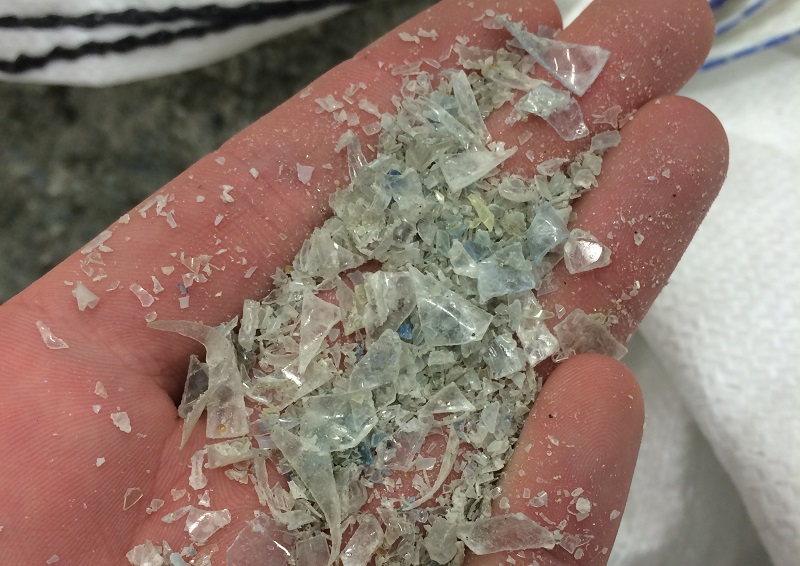India looks at using plastic instead of sand

|
| Using 10% processed plastic waste in Indian concrete could save 820 metric tons of sand a year. |
Contents |
[edit] Introduction
Demand for concrete is increasing fast in India due to a growing economy and rising living standards. However, mass extraction of sand for construction, often via river dredging, has been a problem for a number of years, leading to a high court ruling in 2010 which virtually eliminated sand dredging – with obvious impacts on supply.
At the same time, the Indian Central Pollution Control Board reports that around 15Mt of plastic waste is dumped every day across India, giving rise to long-term environmental concerns.
A solution to both problems was recently proposed by researchers in Goa, who initiated a project to substitute fine sand in concrete mixes with processed waste plastic. The idea would not only encourage the collection and use of waste but would also provide alternative sources of fine material in place of sand in concrete mixes.
[edit] Research challenges
However, volumetric substitution of waste plastic for sand in concrete reduces its density and compressive strength, with higher replacement ratios leading to greater losses in compressive strength.
The issue arises from a combination of poor bond between the plastic and surrounding matrix, excess water due to the hydrophobic plastic surface causing an increase in voids, and failure of the plastic in tension. The goal of the research reported by Thorneycroft et al was therefore to limit to an acceptable degree the immediate loss in compressive strength.
The research project tested 11 new concrete mixes to study five plastic material compositions, three groups of particle sizes, three different aspect ratios and two chemical treatments. The aim was to establish an appropriate choice of material to act as partial replacement for sand.
[edit] Replacement solution
The results showed that a replacement of 10% sand by volume with recycled plastic could be a viable proposition, potentially saving up to 820Mt of sand every year – and a similar amount of plastic waste. However, further investigations are still needed to understand the underlying bond between matrix, plastic and reinforcement.
Methods to improve the bond through treatment are also needed, along with greater understanding of the impact of cement types and the effect plastic has on durability, workability, fire performance and construction cost.
A further avenue of work to support reducing sand consumption is simply to use less concrete. Research has shown that structural materials are often used inefficiently, with savings of 30–50% being feasible in many cases.
[edit] Reducing embodied energy
Another route forward is to consider embodied energy efficiency. This is currently not a high priority for many designers, despite the environmental impacts of material production.
If the incentives of clients, policy makers, architects, engineers and contractors can be aligned such that minimum embodied energy structures were the preferred outcome on all projects, then dramatic reductions in material use may be possible, with multiple positive environmental impacts.
Civil engineers should aim to meet clients’ performance requirements using only the material that’s needed, and no more.
[edit] About this article
This article was written by Dr John Orr, lecturer in concrete structures at Cambridge University. It is based on the authors’ briefing article in the latest issue (172 CE1) of the ICE Civil Engineering Journal and was published in March 2019 on the ICE website.
[edit] Related articles on Designing Buildings Wiki
- Acrylic.
- Biomaterial.
- BREEAM Responsible sourcing of materials.
- Carbon footprint.
- Ecopoints.
- Embodied energy.
- Green Guide to Specification.
- India needs to build more infrastructure fast. Here's how.
- Indian construction industry.
- Indian infrastructure.
- Plastics in construction.
- Recyclable construction materials.
- Site waste management plan.
- Ska rating.
- Sustainable development.
- Whole life costs.
Featured articles and news
RTPI leader to become new CIOB Chief Executive Officer
Dr Victoria Hills MRTPI, FICE to take over after Caroline Gumble’s departure.
Social and affordable housing, a long term plan for delivery
The “Delivering a Decade of Renewal for Social and Affordable Housing” strategy sets out future path.
A change to adoptive architecture
Effects of global weather warming on architectural detailing, material choice and human interaction.
The proposed publicly owned and backed subsidiary of Homes England, to facilitate new homes.
How big is the problem and what can we do to mitigate the effects?
Overheating guidance and tools for building designers
A number of cool guides to help with the heat.
The UK's Modern Industrial Strategy: A 10 year plan
Previous consultation criticism, current key elements and general support with some persisting reservations.
Building Safety Regulator reforms
New roles, new staff and a new fast track service pave the way for a single construction regulator.
Architectural Technologist CPDs and Communications
CIAT CPD… and how you can do it!
Cooling centres and cool spaces
Managing extreme heat in cities by directing the public to places for heat stress relief and water sources.
Winter gardens: A brief history and warm variations
Extending the season with glass in different forms and terms.
Restoring Great Yarmouth's Winter Gardens
Transforming one of the least sustainable constructions imaginable.
Construction Skills Mission Board launch sector drive
Newly formed government and industry collaboration set strategy for recruiting an additional 100,000 construction workers a year.
New Architects Code comes into effect in September 2025
ARB Architects Code of Conduct and Practice available with ongoing consultation regarding guidance.
Welsh Skills Body (Medr) launches ambitious plan
The new skills body brings together funding and regulation of tertiary education and research for the devolved nation.
Paul Gandy FCIOB announced as next CIOB President
Former Tilbury Douglas CEO takes helm.
UK Infrastructure: A 10 Year Strategy. In brief with reactions
With the National Infrastructure and Service Transformation Authority (NISTA).























